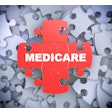Oops -- they've done it again.
Just as the Deficit Reduction Act of 2005 is working its way through radiology, the Centers for Medicare and Medicaid Services (CMS) has issued two new proposed rules for 2008 that could further cut federal insurance reimbursement for imaging services.
The changes involve two major areas that govern federal healthcare programs: the Medicare Physician Fee Schedule (MPFS) and the hospital outpatient prospective payment system (HOPPS). Both rules continue the overall cost-cutting theme sparked by the DRA, and on the MPFS side, target what CMS considers to be self-referral loopholes for diagnostic imaging tests.
"CMS has long been concerned about the risk of overutilization caused by self-referral for in-office, ancillary services that are not within a physician group's traditional scope of practice," said Laura Keidan Martin of the Chicago-based law firm of Katten Muchin Rosenman, in an interview with AuntMinnie.com. "The MPFS proposed rule is their way of taking care of the problem."
Tilting against self-referral
CMS released proposed changes to the MPFS on July 2, which include a 9.9% decrease in payment, as well as changes to the Stark self-referral prohibition and standards that apply to independent diagnostic testing facilities (IDTF). CMS is also suggesting a new rule for the professional and technical components of most diagnostic tests that would prevent payment "markups."
In an advisory brief, Martin and colleague W. Kenneth Davis Jr. listed the effects the proposed rule could have on IDTFs. According to CMS, so-called "under arrangement" contracts (separate supplier/providers agree to provide a hospital a particular service, which once performed, the hospital bills Medicare for and then pays the provider a contracted rate) have increased, the brief stated. The agency believes that these arrangements encourage the service providers to order more tests than necessary, and that these services are often offered in a less "medically resourced" setting, yet billed at higher HOPPS rates.
CMS wants to abolish these deals by changing the definition of a designated health service (DHS) entity from the person or organization that bills Medicare for the DHS to the person or organization that performs the DHS as well as the person or entity that submits claims to Medicare for the DHS, Davis and Martin wrote. The consequence of this proposal would be that the arrangement between a hospital and referring physicians to provide hospital outpatient services would no longer be legal.
The key question for service providers of this type will be deciding whether the ventures are performing the DHS. In a typical deal, where the venture provides a turn-key solution to the hospital or referring physicians' groups, it's likely that CMS will consider the venture to have performed the DHS, which will create a Stark law violation, according to Martin.
CMS also proposes changes to the space and equipment lease exceptions under the Stark law to prevent the use of per-unit-of-service rental payments when the lessor is the referring physician, according to the advisory brief. The agency also proposes to add a new performance standard to the IDTF Program Integrity Manual that states that an IDTF may not "share space, equipment, or staff or sublease its operations to another individual or organization." This could ban the increasingly common practice of per click turn-key leasing, in which an IDTF cuts a deal with a physician group for the group to provide diagnostic imaging to its patients who are not beneficiaries of Medicare or other governmental programs.
Under the proposed rule, if a physician or physician group bills for the professional component (PC) or the technical component (TC) of most diagnostic tests, then they would not be able to mark up what they paid for the PC or TC when they make a Medicare claim for the service.
Intended to eliminate financial incentives for referral, this particular proposal could negatively affect radiology. As Martin and Davis wrote, "If a radiology group accepts assignment from a part-time employed radiologist, and pays the person a per diem, now should the radiology group calculate the per-procedure amount the radiology group is paying in order to assure compliance with the proposed anti-markup rules? Indeed, why should a radiology group even be subject to this new rule, given that radiologists generally don't refer?"
"CMS is suspect of practically any effort to gain revenue from ancillary services," Martin said. "But any other business is allowed to expand into related services. The question is: At what point has CMS gone too far in its attempts to oversee the practice of healthcare?"
Packaging hospital costs
On July 16, 2007, CMS released proposed changes to the hospital outpatient prospective payment system (HOPPS). Key changes in this rule affect radiology services and drugs, therapeutic radiopharmaceuticals, PET scans, and ultrasound ablation of uterine fibroids with MR guidance (MRgFUS). One bit of good news is that the conversion factor for 2008 hospital outpatient payments will go up by 3.3%, from $61.47 to $64.77.
Why the changes affecting radiology? Because its services are made up of many parts, according to Pam Kassing, senior director of economics and health policy at the American College of Radiology (ACR) in Reston, VA.
"Medicare would like to package more (healthcare services), and since radiology billing has a lot of components, CMS considers it to be a natural place to focus," Kassing said in an interview with AuntMinnie.com.
But part of the concern with this packaging approach is that it puts too much pressure on hospital coders, Kassing said.
"It's confusing for hospital coders to track these changes from year to year and to make sure they pick up all the costs for each service component," she said. "The data they report generates future payment rates, and if they leave costs out by mistake, the reimbursement rates are set artificially low."
Big bundles
CMS plans to bundle particular radiology and radiation oncology services into procedural codes, paying one fee for services that now may involve many coding components. Interventional radiology is particularly targeted, according to Kassing: Of the total radiology-related codes to be bundled, interventional radiology coding makes up about 46%.
CMS plans to stop paying separately for current procedural terminology (CPT) or Healthcare Common Procedure Coding System (HCPCS) codes that it believes are "dependent items and services" in the following services:
- Guidance, including MR, CT, ultrasound, and stereotactic. The guidance procedure will be bundled with needle placement, biopsy, and other codes where guidance is associated.
- Image processing. 3D post-processing (CPT codes 76376 and 76377) will not be paid separately, but will be packaged into whatever service initiated its use.
- Interaoperative. Codes that are reported for supportive dependent diagnostic testing during independent procedures like intraoperative ultrasound will be bundled.
- Imaging supervision and interpretation. CMS proposes to package HCPCS codes 72240, 75671, 93555, and contrast into their corresponding primary procedural codes.
- Stereoscopic x-ray (CPT code 77421) will be combined with intensity-modulated radiation therapy (IMRT) (CPT code 77418).
CMS also proposes to package payment for all diagnostic radiopharmaceuticals and contrast agents, regardless of their per-day costs, as well as low-dose-rate (LDR) prostate brachytherapy (which is currently billed by hospitals under CPT codes 55875 and 77778).
Paltry payments?
Also in the proposal is the reassignment of CPT codes for PET/CT to the clinical APC where nonmyocardial PET scans are also assigned, according to ACR. The proposed median payment would be $1,093.52, which would include payment for FDG.
"Right now Medicare pays $850 for a PET scan," Kassing said. "And the actual cost of FDG is between $300 and $350. So the full cost of FDG isn't being considered in this proposal."
Both single and multiple myocardial PET scans will continue to be coded under APC 0307 with a proposed median cost of $2,677.71, higher than 2007's rate, according to CMS, because the bundling approach will include diagnostic radiopharmaceuticals with payment for their related diagnostic nuclear medicine exams.
Cardiac CT and coronary CTA will be placed into two new clinical APCs (0383, Cardiac Computed Tomographic Imaging) and 0282 (Miscellaneous Computerized Axial Tomography). The proposed payment rate for APC 0383 is $313.81, and $105.48 for APC 0282.
The rule proposes that CMS will accept the APC Panel's recommendation to reassign CPT codes 0071T and 0072T for ultrasound ablation of uterine fibroids with MR guidance to APC 0067 with a median cost of $3,869.96.
"Medicare has tried to package payments before," Kassing said. "And they had to reverse the policy because hospital costs weren't coming in accurately. We don't want to see this happen with radiology."
By Kate Madden Yee
AuntMinnie.com staff writer
August 1, 2007
Related Reading
CMS releases 2008 HOPPS proposed rule, July 19, 2007
CMS proposes to cut rates in 2008 MPFS, July 3, 2007
CMS reconsiders coverage for new PET uses, June 26, 2007
CMS examining CT angiography, June 20, 2007
CMS adds to cardiac ultrasound coverage, May 23, 2007
Copyright © 2007 AuntMinnie.com




















